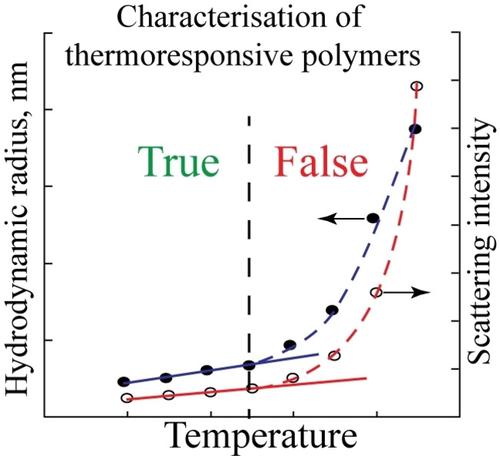当前位置:
X-MOL 学术
›
ChemistrySelect
›
论文详情
Our official English website, www.x-mol.net, welcomes your feedback! (Note: you will need to create a separate account there.)
Temperature Dependence of the Rayleigh Ratio for Toluene: Thermoresponsive Polymers Characterization
ChemistrySelect ( IF 2.1 ) Pub Date : 2021-09-17 , DOI: 10.1002/slct.202102196 Alexey Р. Sivokhin 1 , Oleg A. Kazantsev 1
ChemistrySelect ( IF 2.1 ) Pub Date : 2021-09-17 , DOI: 10.1002/slct.202102196 Alexey Р. Sivokhin 1 , Oleg A. Kazantsev 1
Affiliation

|
Benzene and toluene are commonly used reference substances for static light scattering (SLS) measurements. However, due to the appearance and wide availability of solid-state lasers with various wavelengths, there is a need for data on the Rayleigh ratios for references at various wavelengths. Thermoresponsive polymers, which are widely researched now, can have lower critical solution temperature (LCST) values very close to the human body temperature (30–36 °C). Such polymers can be used to develop efficient means for targeted drug delivery. In this paper, we report how to accurately determine the absolute molecular weights of thermoresponsive polymers by the SLS method. This is especially important when the LCST value of a polymer is close to the room temperature (at which SLS measurements are usually taken), which can lead to overestimated results due to the aggregation of macromolecules. So, it is necessary to carefully select the measurement temperature and, accordingly, data are needed on the temperature dependence of the Rayleigh ratios for a reference sample. The Rayleigh ratios and depolarization factors, ρu and ρv, were first determined for toluene within a wide temperature range (10–50 °C). The temperature dependencies of these parameters were shown to be linear in the whole range investigated. Temperature coefficients for the calculation of the Rayleigh ratios at different scattering geometries were obtained. The particular importance of choosing the optimal measurement temperature when determining the molecular weights of thermoresponsive polymers with low values of LCST using the static light scattering method was demonstrated.
中文翻译:

甲苯瑞利比的温度依赖性:热响应聚合物表征
苯和甲苯是静态光散射 (SLS) 测量常用的参考物质。然而,由于具有各种波长的固态激光器的出现和广泛的可用性,需要有关瑞利比的数据作为各种波长的参考。现在被广泛研究的热响应聚合物可以具有非常接近人体温度 (30–36 °C) 的较低临界溶解温度 (LCST) 值。此类聚合物可用于开发靶向药物递送的有效手段。在本文中,我们报告了如何通过 SLS 方法准确测定热敏聚合物的绝对分子量。当聚合物的 LCST 值接近室温(通常进行 SLS 测量时)时,这一点尤其重要,由于大分子的聚集,这可能导致高估结果。因此,有必要仔细选择测量温度,因此需要有关参考样品瑞利比的温度依赖性的数据。瑞利比和去极化因子,ρu和 ρ v首先在较宽的温度范围 (10–50 °C) 内测定甲苯。这些参数的温度依赖性在所研究的整个范围内显示为线性。获得了用于计算不同散射几何形状下瑞利比的温度系数。证明了在使用静态光散射方法确定具有低 LCST 值的热敏聚合物的分子量时选择最佳测量温度的特别重要性。
更新日期:2021-09-17
中文翻译:

甲苯瑞利比的温度依赖性:热响应聚合物表征
苯和甲苯是静态光散射 (SLS) 测量常用的参考物质。然而,由于具有各种波长的固态激光器的出现和广泛的可用性,需要有关瑞利比的数据作为各种波长的参考。现在被广泛研究的热响应聚合物可以具有非常接近人体温度 (30–36 °C) 的较低临界溶解温度 (LCST) 值。此类聚合物可用于开发靶向药物递送的有效手段。在本文中,我们报告了如何通过 SLS 方法准确测定热敏聚合物的绝对分子量。当聚合物的 LCST 值接近室温(通常进行 SLS 测量时)时,这一点尤其重要,由于大分子的聚集,这可能导致高估结果。因此,有必要仔细选择测量温度,因此需要有关参考样品瑞利比的温度依赖性的数据。瑞利比和去极化因子,ρu和 ρ v首先在较宽的温度范围 (10–50 °C) 内测定甲苯。这些参数的温度依赖性在所研究的整个范围内显示为线性。获得了用于计算不同散射几何形状下瑞利比的温度系数。证明了在使用静态光散射方法确定具有低 LCST 值的热敏聚合物的分子量时选择最佳测量温度的特别重要性。



























 京公网安备 11010802027423号
京公网安备 11010802027423号